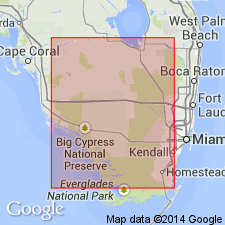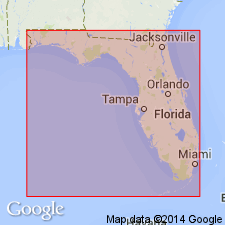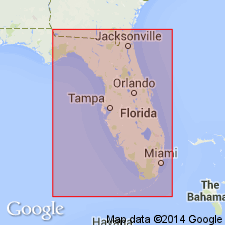
- Usage in publication:
-
- Naples Bay Group
- Modifications:
-
- Named
- Dominant lithology:
-
- Limestone
- Dolomite
- Anhydrite
- AAPG geologic province:
-
- South Florida province
Summary:
Named for Naples Bay, 6 mi northwest of type section. Type section in Humble No. 1 Collier Corp. well, sec. 27, T50S, R26E, Collier Co., southern FL. Type interval is 8607 to 9853 ft. Consists of limestone, dolomite, and anhydrite. Contains no previously named subunits. Overlain by Upper Cretaceous chalk; underlain by a regionally mappable anhydrite bed in Big Cypress Group. Report includes type logs and sections. Age is Early Cretaceous (Comanchean, Washita).
Source: GNU records (USGS DDS-6; Reston GNULEX).

- Usage in publication:
-
- Naples Bay Group*
- Modifications:
-
- Overview
- AAPG geologic province:
-
- South Florida province
Summary:
Naples Bay Group shown (undivided) in the subsurface of eastern Gulf Coastal Plain. Age is Early Cretaceous (late Albian and early Cenomanian, Washitan).
Source: GNU records (USGS DDS-6; Reston GNULEX).

- Usage in publication:
-
- Naples Bay Group*
- Modifications:
-
- Overview
- AAPG geologic province:
-
- Florida platform
Summary:
Early Cretaceous Naples Bay Group, including its Panther Camp, Rookery Bay, and Corkscrew Swamp Formations, used following Faulkner and Applegate (1986, Gulf Coast Association of Geological Societies Transactions, v. 36, p. 83-96) and Lloyd (1991, Florida Geological Survey Information Circular 107, p. 1-62).
Source: GNU records (USGS DDS-6; Reston GNULEX).
For more information, please contact Nancy Stamm, Geologic Names Committee Secretary.
Asterisk (*) indicates published by U.S. Geological Survey authors.
"No current usage" (†) implies that a name has been abandoned or has fallen into disuse. Former usage and, if known, replacement name given in parentheses ( ).
Slash (/) indicates name conflicts with nomenclatural guidelines (CSN, 1933; ACSN, 1961, 1970; NACSN, 1983, 2005, 2021). May be explained within brackets ([ ]).

